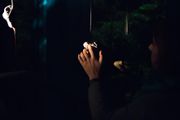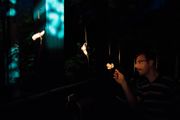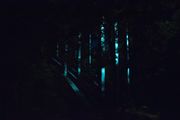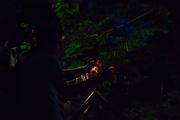User:~brumatana/skala
==SKALA==
- SKALA is an interactive audiovisual installation, a harp made of stones. The harp is mounted vertically on the edge of the stairs under a canyon of Kokra river in Slovenia. Nine stones collected in the canyon of Kokra are tied up with a black rope in the height of the shoulders with a distance of 15cm from each other. The installation is made for the night time, the only source of light comes from the projection and a spotlight that illuminates the stones in a linear way. On the back of the stones we find contact microphones that are connected to Arduino and computer. Above the stairs are 2 projectors mapped on the colons of the bridge over the canyon.
- The stone harp was made to be played by the audience. If you touch the stones the emit sound and change the projection. That happens because the vibration triggers the contact microphones behind the stones that are connected to Arduino and computer. Arduino is connected to the computer where are running two programs; Ableton for the audio part and Resolume Arena for the visual part. The research of the sound was made with field recording of the river and stones during the artistic residency. They were stretched and modulated in Ableton and Paul Stretch. The videos for video mapping are recorded reflections of the light in the water and modified in Adobe Premiere.
- The prupose of the installation was to represent the imperceptible sound and light in time. The city Kranj where we did the installation is made on a rock between two Rivers. Human perception of time is very short compared to a life of a rock that is being brushed and transported by water. We perceive a stone as a static object, but in fact it does a really long way before it becomes sand. The composition of sounds of stones that are travelling is too long for human perception, so we translated it in a short period of time but at the same time we stretched the single sound of a rock so you could hear all the hidden frequencies that are too fast for human ear. The light that reflects on the river is moving very fast and it’s in a big contrast with the movement of the stone, so we slowed it down, that the audience could observe its form in more details.




